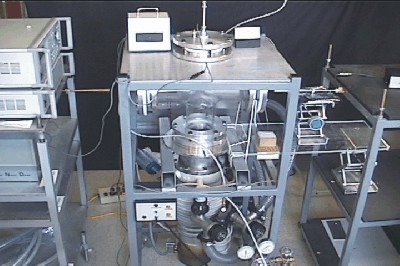![]()
![]()
![]()
The picture shows a part of the terahertz spectrometer that is presently under construction.

We are going to set up a system operating in the frequency range from 177 GHz to 1.03 THz. The BWOs will be stabilised by means of phase lock loop (PLL) techniques, making it possible to perform broad-band searches. The radiation originating from the tube will be coupled into the absorption cell (an evacuated, cross-shaped glass chamber) from one side. The van der Waals complexes will be produced in a pulsed-jet expansion entering from the top of the cross, perpendicular to the incident radiation.
According to the main principle of every absorption spectrometer, the sample absorbs radiation at frequencies corresponding to the energies of particular rovibrational transitions that are intrinsic to the complex under investigation. In our case, this absorption will be detected by a liquid helium cooled hot electron bolometer (“Putley detector”), and the signal will be averaged and analyzed using a personal computer.
![]()
![]()